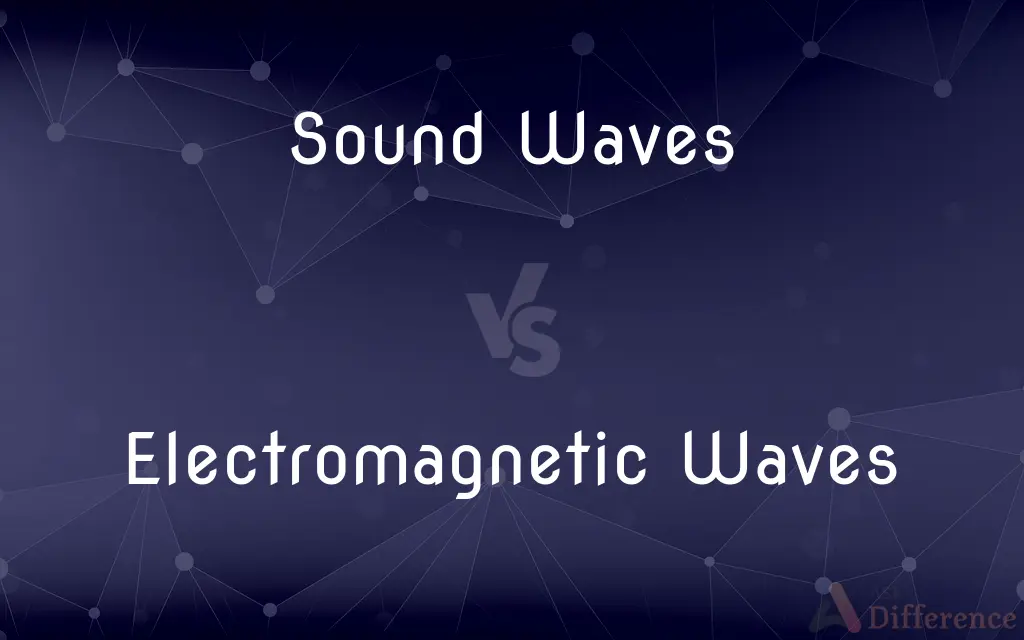Sound Waves vs. Electromagnetic Waves — What's the Difference?
By Tayyaba Rehman — Published on November 27, 2023
Sound Waves are mechanical, requiring a medium to travel; Electromagnetic Waves are energy waves that can propagate through a vacuum.

Difference Between Sound Waves and Electromagnetic Waves
Table of Contents
ADVERTISEMENT
Key Differences
Sound Waves and Electromagnetic Waves fundamentally differ in their nature and propagation. Sound Waves are mechanical waves that necessitate a medium (solid, liquid, or gas) to traverse through, inherently becoming inaudible in a vacuum. In stark contrast, Electromagnetic Waves are capable of traveling through the vacuum of space, exhibiting their capacity to traverse absent a medium.
In regard to their generation, Sound Waves are produced through the vibrations of an object, transmitting through a medium by the displacement of particles. On the other side of the spectrum, Electromagnetic Waves are generated by the vibration of charged particles, often electrons, and do not rely on atomic or molecular displacement for their propagation, ensuring their movement through a vacuum is unimpeded.
Understanding Sound Waves involves acknowledging their reliance on the kinetic motion of particles within a medium, as they transport energy through the vibrations of these particles. Meanwhile, Electromagnetic Waves transport energy through oscillating electric and magnetic fields, unconfined by a medium, allowing them to travel through various environments, including a vacuum, unhindered.
When considering velocity, Sound Waves move at a speed determined by the medium through which they travel, affected by factors like temperature and pressure. Electromagnetic Waves, however, always propagate at the speed of light in a vacuum, and slightly less in various other media due to interactions with matter.
Considering applications, Sound Waves find usage in various technologies like sonar and ultrasound, where the mechanical wave properties are utilized for detection and imaging. Conversely, Electromagnetic Waves, with their spectrum encompassing radio to gamma rays, find ubiquitous applications including communication technologies, medical imaging, and numerous scientific applications.
ADVERTISEMENT
Comparison Chart
Nature
Mechanical
Non-mechanical
Medium Requirement
Requires a medium
Can travel through a vacuum
Generation
Via vibrations of an object
Via vibrations of charged particles
Speed
Variable, depending on the medium
Speed of light (c) in a vacuum
Applications
Sonar, Ultrasound
Communication, medical imaging, scientific applications
Compare with Definitions
Sound Waves
Sound Waves require a medium to propagate.
Sound Waves cannot be heard in a vacuum since they need a medium.
Electromagnetic Waves
Electromagnetic Waves have varying frequencies and wavelengths.
X-rays have shorter wavelengths than visible light within the Electromagnetic Waves spectrum.
Sound Waves
Sound Waves can be reflected and refracted.
Sound Waves bounce off walls, causing echoes.
Electromagnetic Waves
Electromagnetic Waves consist of oscillating electric and magnetic fields.
Light is an example of Electromagnetic Waves.
Sound Waves
Sound Waves transport energy via particle vibrations.
Sound Waves can make a paper flutter due to energy transportation.
Electromagnetic Waves
Electromagnetic Waves travel at the speed of light.
Sound Waves
Sound Waves are mechanical vibrations transmitted through a medium.
Sound Waves from a bell travel through air, reaching our ears.
Electromagnetic Waves
Electromagnetic Waves can propagate without a medium.
Electromagnetic Waves from the Sun reach Earth through the vacuum of space.
Sound Waves
Sound Waves have properties like wavelength and frequency.
The pitch of Sound Waves is determined by their frequency.
Electromagnetic Waves
Electromagnetic Waves carry energy from one place to another.
The warmth from sunlight is energy transported by Electromagnetic Waves.
Common Curiosities
Can Sound Waves propagate in a vacuum?
No, Sound Waves require a medium to travel through.
How are Sound Waves generated?
Through the vibrations of objects, propagating through a medium.
What creates Electromagnetic Waves?
The oscillation of charged particles generates Electromagnetic Waves.
What differentiates Sound Waves from Electromagnetic Waves?
Sound Waves require a medium; Electromagnetic Waves do not.
Can humans hear all Sound Waves?
No, humans typically hear frequencies between 20 Hz and 20 kHz.
Is the speed of Sound Waves constant?
No, it varies depending on factors like the medium, temperature, and pressure.
Can Electromagnetic Waves be harmful?
Yes, some like X-rays and gamma rays can be harmful in high doses.
What is a practical application of Electromagnetic Waves?
They are used in various ways, including radio communication.
Can Sound Waves be used for imaging?
Yes, ultrasound uses Sound Waves for imaging purposes.
Do Electromagnetic Waves require a medium for propagation?
No, Electromagnetic Waves can travel through a vacuum.
Are Sound Waves affected by temperature?
Yes, temperature changes can alter Sound Waves' speed.
Can Electromagnetic Waves be visible?
Yes, visible light is a part of the Electromagnetic Waves spectrum.
Do Electromagnetic Waves always travel at the speed of light?
Yes, in a vacuum, and slightly less through other media.
Do Sound Waves reflect off surfaces?
Yes, Sound Waves can reflect and cause phenomena like echoes.
Do Electromagnetic Waves have a spectrum?
Yes, ranging from radio waves to gamma rays.
Share Your Discovery

Previous Comparison
Eastern Time Zone vs. Central Time Zone
Next Comparison
Prophase I vs. Prophase IIAuthor Spotlight
Written by
Tayyaba RehmanTayyaba Rehman is a distinguished writer, currently serving as a primary contributor to askdifference.com. As a researcher in semantics and etymology, Tayyaba's passion for the complexity of languages and their distinctions has found a perfect home on the platform. Tayyaba delves into the intricacies of language, distinguishing between commonly confused words and phrases, thereby providing clarity for readers worldwide.














































